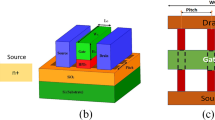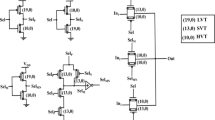Abstract
This article presents the low-power ternary arithmetic logic unit (ALU) design in carbon nanotube field-effect transistor (CNFET) technology. CNFET unique characteristic of geometry-dependent threshold voltage is employed in the multi-valued logic design. The ternary logic benefit of reduced circuit overhead is exploited by embedding multiple modules within a block. The existence of symmetric literals among various single shift and dual shift operators in addition and subtraction operations results in the optimized realization of adder/subtractor modules. The proposed design is based on the notion of multiplexing either arithmetic, logical or miscellaneous operations, depending upon the status of input selection trits. The results obtained by the synopsis HSPICE simulator with the Stanford 32 nm CNFET technology illustrate that the proposed processing modules outperform their counterparts in terms of power consumption, energy consumption and device count. The proposed methodology leads to saving in power consumption and energy consumption (PDP) of 62% and 58%, respectively, on the benchmark circuit of the ALU [full adder/subtractor (FAS)]. Furthermore, for the 2-trit multiplier design, the enhanced performance at the architecture and circuit level is achieved through the optimized designs of various adder and multiplier circuits.












Similar content being viewed by others
References
P.C. Balla, A. Antoniou, Low power dissipation MOS ternary logic family. IEEE J. Solid State Circuits 19(5), 739–749 (1984)
N.H. Bastani, M.H. Moaiyeri, K. Navi, Carbon nanotube field effect transistor switching logic for designing efficient ternary arithmetic circuits. J. Nanoelectron. Optoelectron. 12(2), 118–129 (2017)
J. Deng, H.S.P. Wong, A compact SPICE model for carbon-nanotube field-effect transistors including nonidealities and its application—part I: model of the intrinsic channel region. IEEE Trans. Electron Device 54(12), 3186–3194 (2007)
J. Deng, H.S.P. Wong, A compact SPICE model for carbon-nanotube field-effect transistors including nonidealities and its application—part II: full device model and circuit performance benchmarking. IEEE Trans. Electron Device 54(12), 3195–3205 (2007)
A. Dhande, V. Ingole, Design and implementation of 2 bit ternary ALU slice, in Proceedings of the International Conference IEEE-Science of Electronic, Technologies of Information Telecommunications, pp. 17–21 (2005)
E. Dubrova, Multiple-valued logic in VLSI: challenges and opportunities, in Proceedings of Norchip, pp. 340–350 (1999)
S.A. Ebrahimi, P. Keshavarzian, S. Sorouri, Low power CNTFET-based ternary full adder cell for nanoelectronics. Int. J. Soft Comput. 2(2), 291–295 (2012)
G. Hills et al., Understanding energy efficiency benefits of carbon nanotube field-effect transistors for digital VLSI. IEEE Trans. Nanotechnol. 17(6), 1259–1269 (2018)
F. Jafarzadehpour, P. Keshavarzian, Low-power consumption ternary full adder based on CNTFET. IET Circuits Devices Syst. 10(5), 365–374 (2016)
M.R. Khezeli, M.H. Moaiyeri, A. Jalali, Analysis of crosstalk effects for multiwalled carbon nanotube bundle interconnects in ternary logic and comparison with cu interconnects. IEEE Trans. Nanotechnol. 16(1), 107–117 (2017)
Y. Lin, J. Appenzeller, J. Knoch, P. Avouris, High-performance carbon nanotube field-effect transistor with tunable polarities. IEEE Trans. Nanotechnol. 4(5), 481–489 (2005)
S. Lin, Y.B. Kim, F. Lombardi, CNTFET-based design of ternary logic gates and arithmetic circuits. IEEE Trans. Nanotechnol. 10(2), 217–225 (2011)
M.H. Moaiyeri, A. Doostaregan, K. Navi, Design of energy-efficient and robust ternary circuits for nanotechnology. IET Circuits Devices Syst. 5(4), 285–296 (2011)
S.L. Murotiya, A. Gupta, Design of CNTFET based 2-bit ternary ALU for nano-electronics. Int. J. Electron. 101(9), 1244–1257 (2014)
S.L. Murotiya, A. Gupta, Hardware-efficient low-power 2-bit ternary ALU design in CNTFET technology. Int. J. Electron. 103(5), 913–927 (2016)
A. Naeemi, R. Sarvari, J. D. Meindl, On-chip interconnect networks at the end of the roadmap: limits and nanotechnology opportunities, in Proceedings of the International Interconnect Technology Conference, pp. 201–203 (2006)
L.M. Peng, Z. Zhang, S. Wang, Carbon nanotube electronics: recent advances. Mater. Today 17(9), 433–442 (2014)
V. Prasad, A. Banerjee, D. Das, Design of ternary logic circuits using CNTFET. in International Symposium on Devices, Circuits and Systems (ISDCS) (IEEE, 2018), pp. 1–6
A. Raychowdhury, K. Roy, Carbon nanotube electronics: design of high-performance and low-power digital circuits. IEEE Trans. Circuits Syst. 54(11), 2391–2401 (2007)
S.K. Sahoo, G. Akhilesh, R. Sahoo, M. Muglikar, High performance ternary adder using CNTFET. IEEE Trans. Nanotechnol. 16(03), 368–374 (2017)
T. Sharma, L. Kumre, CNTFET-based design of ternary arithmetic modules. Circuits Syst. Signal Process. 38(10), 4640–4666 (2019)
M.M. Shulaker et al., Three-dimensional integration of nanotechnologies for computing and data storage on a single chip. Nature 547(74), 74–78 (2017)
M. Shulaker, G. Hills, N. Patil, H. Wei, H.Y. Chen, H.S. Wong, S. Mitra, Carbon nano tube computer. Nature 501, 526–535 (2013)
V. Sridevi, T. Jayanthy, Minimization of CNTFET ternary combinational circuits using negation of literals technique. Arab. J. Sci. Eng. 39(6), 4875–4890 (2014)
B. Srinivasu, K. Sridharan, Low-complexity multi-ternary digit multiplier design in CNTFET technology. IEEE Trans. Circuits Syst. 63(8), 753–757 (2016)
B. Srinivasu, K. Sridharan, Carbon nanotube FET-based low-delay and low-power multi-digit adder designs. IET Circuits Devices Syst. 11(4), 352–384 (2017)
S. Tabrizchi, A. Panahi, F. Shari, K. Navi, N. Bagherzadeh, Method for designing ternary adder cells. IET Circuits Devices Syst. 11(5), 465–470 (2017)
S. Tabrizchi, H. Sharifi, F. Sharifi, K. Navi, Design of ultra low power ternary half adder and multiplier for nanotechnology. J. Nanoelectron. Optoelectron. 11(6), 730–737 (2016)
G.S. Tulevski, Toward high-performance digital logic technology with carbon nanotubes. ACS Nano 8(9), 8730–8745 (2014)
C. Vudadha, S.P. Parlapalli, V. Sreehari, M.B. Srinivas, in CNFET Based Ternary Magnitude Comparator in the Proceedings of International Symposium on Communications and Information Technologies (ISCIT), pp. 942–946 (2012)
C. Vudadha, S.P. Parlapalli, M.B. Srinivas, Energy efficient design of CNFET-based multi-digit ternary adders. Microelectron. J. 75, 75–86 (2018)
C. Wang, K. Ryu, A. Badmaev, J. Zhang, C. Zhou, Metal contact engineering and registration-free fabrication of complementary metal-oxide semiconductor integrated circuits singaligned carbon nanotubes. ACS Nano 5, 1147–1153 (2011)
D. Zhong, Y. Xie, Z. Zhang, L. Peng, Speeding up carbon nanotube integrated circuits through three dimensional architecture. Nano Res. 12(8), 1810–1816 (2019)
Acknowledgements
This publication is an outcome of the R & D work undertaken project under the Visvesvaraya PhD Scheme of Ministry of Electronics & Information Technology, Government of India, being implemented by Digital India Corporation.
Author information
Authors and Affiliations
Corresponding author
Additional information
Publisher's Note
Springer Nature remains neutral with regard to jurisdictional claims in published maps and institutional affiliations.
Rights and permissions
About this article
Cite this article
Sharma, T., Kumre, L. Energy-Efficient Ternary Arithmetic Logic Unit Design in CNTFET Technology. Circuits Syst Signal Process 39, 3265–3288 (2020). https://doi.org/10.1007/s00034-019-01318-4
Received:
Revised:
Accepted:
Published:
Issue Date:
DOI: https://doi.org/10.1007/s00034-019-01318-4




